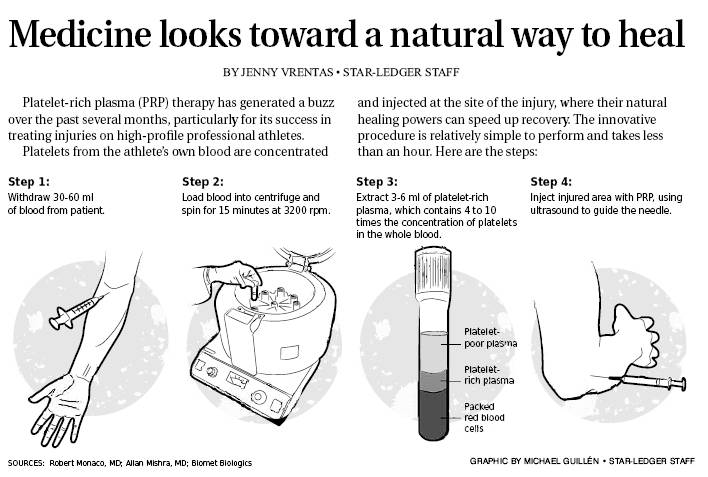Platelet Rich Plasma 
What is Platelet Rich Plasma?
Platelet rich plasma (PRP) is a therapy that utilizes a patient’s own blood to stimulate a healing response within a damaged tissue or joint. This form of therapy takes cutting edge technology and combines it with the body’s natural ability to heal itself.
PRP is made by taking a small sample of a patient’s own blood and spinning the sample in a centrifuge for fifteen minutes. This process concentrates platelets and white blood cells in what is called a “buffy coat” that is extracted and delivered to the injured area. Growth factors in the platelets recruit and produce cells necessary for healing.
PRP’s Range of Application
PRP can be used to relieve a broad spectrum of conditions, including:
• Knee arthritis and meniscal injury
• Pain related to osteoarthritis
• Tennis elbow (lateral epicondylitis)
• Achilles tendonitis (inflammation and swelling of the Achilles tendon)
• Patellar tendonitis (inflammation of the patellar tendon, also called “Jumper’s Knee”)
• Joint capsuler laxity
• Rotator cuff tendinopathy
• Work-related injuries
• Sports-related injuries
• And Many More!
How Does it Work And is it Similar to Prolotherapy?
PRP mimics the natural healing process that occurs after a wound. Conditions such as arthritis, sports injuries, tendonitis and ligament instability, for example, can remain beyond the recognition of the natural repair mechanisms of the body. Prolotherapy and PRP are ways in which the areas that need repair are finally recognized by the body as areas that require repair. Prolotherapy drops a signal into the tissue (with dextrose) that attracts platelets and white blood cells into the area to release growth factors. PRP is three times as effective as prolotherapy as it directly gives the area the components it needs for repair; platelets and white blood cells which directly and quickly bring about healing. Prolotherapy acts like a beacon to attract the work crew. PRP brings the work crew right to the site.
What is the Success Rate With PRP?
PRP therapy has a success rate of about 85%. While the patient may experience some heightened pain for up to seven days after injection, PRP therapy promotes long lasting healing and more permanent pain relief.
To Use PRP or Prolotherapy First?
Because of the high success of prolotherapy, PRP is not something we normally think of as a first line solution. For really, really, bad tears or injuries, especially if someone has had some prolotherapy elsewhere, we may use it as a first-line therapy. For those who do get PRP solution as their prolotherapy solution, we typically see them for follow-up in four to six weeks. Generally, people know by the second PRP treatment whether it will work or not. Overall the results have been extremely positive; it is very safe and there have been no reactions related to the PRP solution.
When to Consider PRP instead of Prolotherapy?
• You have failed with the prolotherapy solution
• Your injury is very severe
• You have a complex ligament injury
• You have a complex tendon injury
• Tendinosis is your diagnosis
• MRI shows labral tear
• MRI shows a very complex meniscal tear